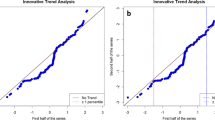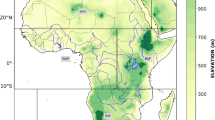Abstract
Drought is known as one of the main natural hazards especially in arid and semi-arid regions where there are considerable issues in regard to water resources management. Also, climate changes has been introduced as a global concern and therefore, under conditions of climate change and global warming, the investigation of drought severity trend in regions such as Iran which is mainly covered by arid and semi-arid climate conditions is in the primary of importance. Therefore, in this study, based on the application of Reconnaissance Drought Index (RDI) for assessment drought severities, and also the implementation of non-parametric Mann- Kendall statistics and Sen’s slope estimator, the trends in different time series of RDI (3, 6, 9, 12, 18 and 24 monthly time series) were investigated. Results indicated the frequent decreasing trends in RDI time series particularly for long term time series (12, 18 and 24 monthly time series) than short term ones. Decreasing trend in RDI time series means the increasing trend in drought severities. Since the water resources especially ground water in most cases are affected by long term droughts, therefore, increasing trend in drought intensities in long term ones can be a threat for water resources management in surveyed areas.







Similar content being viewed by others
References
Abramowitz M, Stegun IA (1965) Handbook of mathematical functions: with formulas, graphs, and mathematical tables. Applied Mathematics Series - 55. Washington D.C
Ahani H, Kherad M, Kousari M, Rezaeian-Zadeh M, Karampour M, Ejraee F, Kamali S (2012) An investigation of trends in precipitation volume for the last three decades in different regions of Fars province, Iran. Theor Appl Climatol 109:361–382
Ahani H, Kherad M, Kousari M, Roosmalen L, Aryanfar R, Hosseini S (2013) Non-parametric trend analysis of the aridity index for three large arid and semi-arid basins in Iran. Theor Appl Climatol 112:553–564
Ahrens C (1998) Essentials of meteorology, an introduction to the atmosphere, 2nd edn. Publishing Company, Wadsworth
Allen RG, Pereira LS, Raes D, Smith M (1998) Crop evapotranspiration, FAO irrigation and drainage paper 56. Food and Agriculture Organisation, Rome
Arora M, Goel NK, Singh P (2005) Evaluation of temperature trends over India. Hydrol Sci J 50:81–93
Asadi Zarch M, Malekinezhad H, Mobin M, Dastorani M, Kousari M (2011) Drought monitoring by Reconnaissance Drought Index (RDI) in Iran. Water Resour Manag 25:3485–3504
Bari Abarghouei H, Asadi Zarch M, Dastorani M, Kousari M, Safari Zarch M (2011) The survey of climatic drought trend in Iran. Stochast Environ Res Risk Assess 25:851–863
Chen H, Guo S, Cy X, Singh VP (2007) Historical temporal trends of hydro-climatic variables and runoff response to climate variability and their relevance in water resource management in the Hanjiang basin. J Hydrol 344:171–184
Cindrić K, Pasarić Z, Gajić-Čapka M (2010) Spatial and temporal analysis of dry spells in Croatia. Theor Appl Climatol 102:171–184
Dastorani M, Afkhami H (2011) Application of artificial neural networks on drought prediction in Yazd (Central Iran). J DESERT 16:39–48
Dinpashoh Y, Jhajharia D, Fakheri-Fard A, Singh VP, Kahya E (2011) Trends in reference crop evapotranspiration over Iran. J Hydrol 399:422–433
Duhan D, Pandey A (2013) Statistical analysis of long term spatial and temporal trends of precipitation during 1901–2002 at Madhya Pradesh, India. Atmos Res 122:136–149
Eslamian S, Khordadi MJ, Abedi-Koupai J (2011) Effects of variations in climatic parameters on evapotranspiration in the arid and semi-arid regions. Glob Planet Chang 78:188–194
Hirsch R, Helsel D, Cohn T, Ilroy E (1993) Statistical analysis of hydrologic data. Handbook of hydrology. McGraw-Hill, New York
IPCC (2007) Climate change 2007: the physical science basis. Contribution of working group I to the fourth assessment report of the intergovernmental panel on climate change. In: Solomon S, Qin D, Manning M, Chen Z, Marquis M, Averyt KB, Tignor M, Miller HL (eds). Cambridge University Press, Cambridge, United Kingdom and New York, NY, USA
Kahya E, Kalaycı S (2004) Trend analysis of streamflow in Turkey. J Hydrol 289:128–144
Karamouz M, Rasouli K, Nazif S (2009) Development of a hybrid index for drought prediction: case study. J Hydrol Eng 14:617–627
Kendall MG (1975) Rank correlation methods. Griffin, London
Khalili D, Farnoud T, Jamshidi H, Kamgar-Haghighi A, Zand-Parsa S (2011) Comparability analyses of the SPI and RDI meteorological drought indices in different climatic zones. Water Resour Manag 25:1737–1757
Kharraz JE, El-Sadek A, Ghaffour N, Mino E (2012) Water scarcity and drought in WANA countries. Procedia Eng 33:14–29
Kirono DGC, Kent DM, Hennessy KJ, Mpelasoka F (2011) Characteristics of Australian droughts under enhanced greenhouse conditions: results from 14 global climate models. J Arid Environ 75:566–575
Kousari MR, Ahani H (2012) An investigation on reference crop evapotranspiration trend from 1975 to 2005 in Iran. Int J Climatol 32:2387–2402
Kousari M, Asadi Zarch M (2011) Minimum, maximum, and mean annual temperatures, relative humidity, and precipitation trends in arid and semi-arid regions of Iran. Arab J Geosci 4:907–914
Kousari M, Ekhtesasi M, Tazeh M, Saremi Naeini M, Asadi Zarch M (2011) An investigation of the Iranian climatic changes by considering the precipitation, temperature, and relative humidity parameters. Theor Appl Climatol 103:321–335
Kousari MR, Ahani H, Hakimelahi H (2013) An investigation of near surface wind speed trends in arid and semiarid regions of Iran. Theor Appl Climatol 114:1–16
Malekinezhad H (2009) Study on the water availability in Iran, using the international water indicators. 8th International Congress on Civil Engineering, Shiraz, Iran
Mann HB (1945) Non-parametric tests against trend. Econometrica 13:245–259
Mishra A, Singh V (2010) A review of drought concepts. J Hydrol 391:202–216
Modarres R, de Paulo Rodrigues da Silva V (2007) Rainfall trends in arid and semi-arid regions of Iran. J Arid Environ 70(2):344–355
Modarres R, Sarhadi A (2009) Rainfall trends analysis of Iran in the last half of the twentieth century. J Geophys Res Atmos 114, D03101
Rahimikhoob A (2010) Estimation of evapotranspiration based on only air temperature data using artificial neural networks for a subtropical climate in Iran. Theor Appl Climatol 101:83–91
Raziei T, Arasteh P, Saghafian B (2005) Annual rainfall trend in arid & semi–arid regions of Iran. ICID21st European regional Conference,. 20–28, Frankfurt (Oder) and Slubice—Germany and Poland
Sen PK (1968) Estimates of the regression coefficient based on Kendall’s Tau. J Am Stat Assoc 63:1379–1389
She D, Xia J, Song J, Du H, Chen J, Wan L (2012) Spatio-temporal variation and statistical characteristic of extreme dry spell in Yellow River Basin, China. Theor Appl Climatol 112:1–13
Silva V (2004) On climate variability in Northeast of Brazil. J Arid Environ 58:575–596
Sneyers R (1990) On the statistical analysis of series of observations. WMO Technical Note 143 World Meteorological Organization,Geneva, p 192
Soltani S, Saboohi R, Yaghmaei L (2012) Rainfall and rainy days trend in Iran. Clim Chang 110:187–213
Tabari H, Talaee PH (2011) Temporal variability of precipitation over Iran: 1966–2005. J Hydrol 396:313–320
Tabari H, Marofi S, Aeini A, Talaee PH, Mohammadi K (2011) Trend analysis of reference evapotranspiration in the western half of Iran. Agric For Meteorol 151:128–136
Tsakiris G, Vangelis H (2005) Establishing a drought index incorporating evapotranspiration. Eur Water 9(10):3–11
Tsakiris G, Pangalou D, Tigkas D, Vangelis H (2007a) Assessing the areal extent of drought. Water resources management: new approaches and technologies, european water resources association, Chania, Crete -Greece, 14–16 June
Tsakiris G, Pangalou D, Vangelis H (2007b) Regional drought assessment based on the Reconnaissance Drought Index (RDI). Water Resour Manag 21:821–833
Tsakiris G, Nalbantis I, Pangalou D, Tigkas D, Vangelis H (2008) Drought meteorological monitoring network design for the Reconnaissance Drought Index (RDI), 1st International Conference “Drought Management: Scientific and Technological Innovations”. Zaragoza – Spain
Tsakiris G, Nalbantis I, Cavadias G (2011) Regionalization of low flows based on canonical correlation analysis. Adv Water Resour 34:865–872
Tsakiris G, Nalbantis I, Vangelis H, Verbeiren B, Huysmans M, Tychon B, Jacquemin I, Canters F, Vanderhaegen S, Engelen G, Poelmans L, Becker P, Batelaan O (2013) A system-based paradigm of drought analysis for operational management. Water Resour Manag 27:5281–5297
Vangelis H, Tigkas D, Tsakiris G (2013) The effect of PET method on Reconnaissance Drought Index (RDI) calculation. J Arid Environ 88:130–140
Yu Y, Zou S, Whittemore D (1993) Non-parametric trend analysis of water quality data of rivers in Kansas. J Hydrol 150:61–80
Yue S, Wang CY (2002) Applicability of the pre-whitening to eliminate the influence of serial correlation on the Mann–Kendall test. Water Resour Res 38
Zhai L, Feng Q (2008) Spatial and temporal pattern of precipitation and drought in Gansu Province, Northwest China. Nat Hazards 49:1–24
Zhang Q, Liu C, Xu CY, Xu YP, Jiang T (2006) Observed trends of water level and streamflow during past 100 years in the Yangtze River basin, China. J Hydrol 324:255–265
Zhang Q, Singh VP, Li J, Jiang F, Bai y (2012) Spatio-temporal variations of precipitation extremes in Xinjiang, China. J Hydrol 434–435:7–18
Zhu Y, Day RL (2005) Analysis of streamflow trends and the effects of climate in Pennsylvania, 1971 to 2001. J Am Water Resour Assoc 41:1393–1405
Acknowledgments
The authors greatly acknowledge the financial supports of Yazd University, provided for running the present project. Furthermore, authors greatly appreciate the technical support of Management Center for Strategic Projects in Fars Organization Centre of Jihad-Agriculture of Iran.
Author information
Authors and Affiliations
Corresponding author
Rights and permissions
About this article
Cite this article
Kousari, M.R., Dastorani, M.T., Niazi, Y. et al. Trend Detection of Drought in Arid and Semi-Arid Regions of Iran Based on Implementation of Reconnaissance Drought Index (RDI) and Application of Non-Parametrical Statistical Method. Water Resour Manage 28, 1857–1872 (2014). https://doi.org/10.1007/s11269-014-0558-6
Received:
Accepted:
Published:
Issue Date:
DOI: https://doi.org/10.1007/s11269-014-0558-6




